Methylene blue is an oxidation-reduction agent. The intravenous form of methylene blue is approved by the FDA for the treatment of pediatric and adult patients with acquired methemoglobinemia. Historically, it has been widely used in Africa to treat malaria, but now it disappeared when chloroquine (CQ) and other drugs entered the market. Its use as an urinary tract antiseptic has also been investigated.
Methylthioninium chloride (INN, or methylene blue, proposed trade name Rember) is an investigational drug being developed by the University of Aberdeen and TauRx Therapeutics that has been shown in early clinical trials to be an inhibitor of Tau protein aggregation. The drug is of potential interest for the treatment of patients with Alzheimer's disease.
Methylene Blue
Methylene Blue is used in the treatment of depression and Methaemoglobinemia.
Methylene blue acts as a reducing agent to reduce methemoglobin to hemoglobin. It is reduced to leucomethylene blue in the red blood cells of our body, by combining with a chemical nicotinamide adenine dinucleotide phosphate (NADPH), in the presence of an enzyme called NADPH reductase. Leucomethylene blue reduces methemoglobin to hemoglobin and restores the oxygen carrying capacity of hemoglobin. This helps in the treatment of Methemoglobinemia.
















